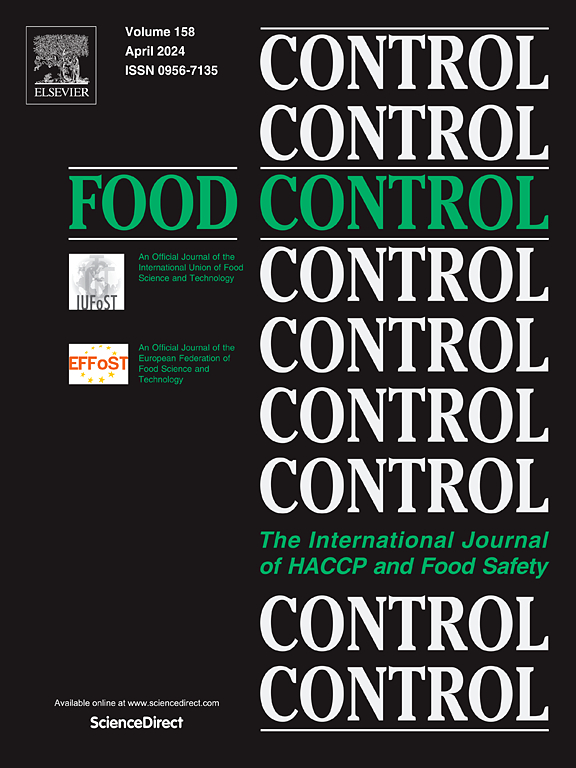赭曲霉毒素A在小麦和面粉中的分布有多广?系统回顾和荟萃分析
IF 5.6
1区 农林科学
Q1 FOOD SCIENCE & TECHNOLOGY
引用次数: 0
摘要
赭曲霉毒素A (OTA)是一种剧毒且热稳定的真菌毒素,对全球食品安全构成重大挑战,特别是对人类主食小麦而言。本系统综述和荟萃分析调查了2000年至2023年间不同气候带和地理区域小麦和面粉中的OTA污染。本研究发现,参考Köppen-Geiger气候分类,干旱区受污染最严重,污染率为53% (95% CI: 35-70%),其次是温带30% (95% CI: 20-42%),大陆带21% (95% CI: 10-33%)。极地和热带地区的患病率最低。从区域来看,亚洲和非洲主要位于干旱地区,报告的患病率最高,分别为44%(95%置信区间:30-59%)和31%(95%置信区间:15-50%)。小麦品种之间存在显著差异,与全谷物(27%,95% CI: 19-36%)相比,面粉显示出更高的OTA污染率(41%,95% CI: 29-54%),这是由于加工过程中霉菌生长增加和储存条件不足造成的。小麦和面粉中的模拟平均OTA浓度被认为基本安全。然而,面粉的含量接近监管限值,93.1%的样品符合欧盟的阈值(谷物5 μg/kg,面粉3 μg/kg)。这项研究强调,需要在高风险地区提高警惕,以确保小麦食品供应的安全,保护全球公众健康,并强调严格的储存和加工做法对减轻OTA污染的重要性。本文章由计算机程序翻译,如有差异,请以英文原文为准。
How widespread and concerning is Ochratoxin A in wheat and flour? A systematic review and meta-analysis
Ochratoxin A (OTA), a highly toxic and thermally stable mycotoxin, poses a significant challenge to global food safety, particularly in wheat, a staple of human diets. This systematic review and meta-analysis investigated OTA contamination in wheat and flour across climatic zones and geographic regions between 2000 and 2023. This study found that, with reference to the Köppen-Geiger climate classification, the Arid zone emerged as the most affected, with a contamination rate of 53% (95% CI: 35–70%), followed by the Temperate zone at 30% (95% CI: 20–42%) and the Continental zone at 21% (95% CI: 10–33%). Minimal prevalence was observed in the Polar and Tropical zones. Regionally, Asia and Africa, largely situated within the Arid zone, reported the highest prevalence rates of 44% (95% CI: 30–59%) and 31% (95% CI: 15–50%), respectively. A notable disparity was found between wheat forms, with flour showing higher OTA contamination rates (41%, 95% CI: 29–54%) compared to whole grain (27%, 95% CI: 19–36%), attributed to increased mould growth during processing and inadequate storage conditions. Simulated average OTA concentrations in wheat and flour were deemed largely safe. However, values in flour approached regulatory limits, with 93.1% of samples meeting EU thresholds (5 μg/kg for grains, 3 μg/kg for flour). This study highlights the need for heightened vigilance in high-risk regions to ensure the safety of wheat-based food supplies and protect public health globally, emphasising the importance of stringent storage and processing practices to mitigate OTA contamination.
求助全文
通过发布文献求助,成功后即可免费获取论文全文。
去求助
来源期刊

Food Control
工程技术-食品科技
CiteScore
12.20
自引率
6.70%
发文量
758
审稿时长
33 days
期刊介绍:
Food Control is an international journal that provides essential information for those involved in food safety and process control.
Food Control covers the below areas that relate to food process control or to food safety of human foods:
• Microbial food safety and antimicrobial systems
• Mycotoxins
• Hazard analysis, HACCP and food safety objectives
• Risk assessment, including microbial and chemical hazards
• Quality assurance
• Good manufacturing practices
• Food process systems design and control
• Food Packaging technology and materials in contact with foods
• Rapid methods of analysis and detection, including sensor technology
• Codes of practice, legislation and international harmonization
• Consumer issues
• Education, training and research needs.
The scope of Food Control is comprehensive and includes original research papers, authoritative reviews, short communications, comment articles that report on new developments in food control, and position papers.
 求助内容:
求助内容: 应助结果提醒方式:
应助结果提醒方式:


